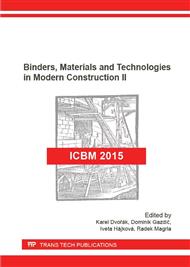p.157
p.162
p.167
p.171
p.178
p.183
p.190
p.196
p.201
The Effect of Modifications on Humidity Parameters of Cement Mortar
Abstract:
Current wall constructions utilize cement mortars, the properties of which have been modified with introducing lime or plasticizers. The complex structure of these mortars as well as their very large inner area results in large differences in capillary moisture transport. Macroscopic studies do not allow to accurately predict the mortar behaviour in contact with water. Capillary rise as well as drying and freezing of water are dependent on the size and the layout of pores. The biggest adsorption capacity is featured by micropores. Moisture transport takes place in mesoporous material, and moisture adsorption takes place on the surface of such materials. Macropores mainly act as a transport medium and carry moisture to mesoporous material and micropores. In terms of mesoporous material and macropores mercury porosimetry is more suitable. Mortar structure plays an important role in the moisture transport. Mortar additives, that have been introduced in the form of lime and plasticizers, modify the distribution and size of pores. Porosimetric study results concerning selected mortars have been presented in this article. The structure changes resulting from the introduction additives to mortars have been analyzed and the impact on humidity of such mortars has been defined.
Info:
Periodical:
Pages:
178-182
Citation:
Online since:
August 2016
Authors:
Keywords:
Price:
Сopyright:
© 2016 Trans Tech Publications Ltd. All Rights Reserved
Share:
Citation:


